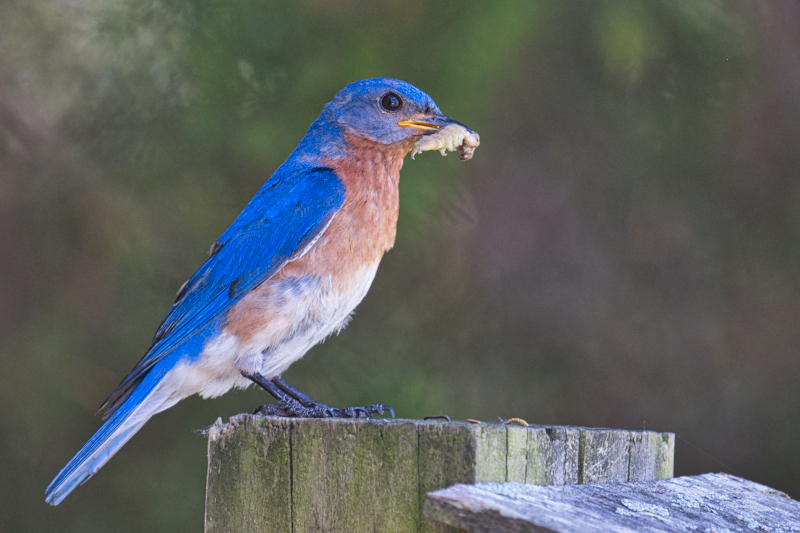Recently, I had the pleasure of photographing a male Eastern Bluebird carrying a caterpillar in my Arkansas yard. This encounter came shortly after I had shared my plans to replace and reorient one of the bluebird nesting boxes earlier in June. However, upon inspecting the box, I discovered that a new nest had already been built, and the baby bluebirds had hatched. With young chicks in the nest, the timing for any adjustments was no longer suitable.

The Setup and Photograph
Fortunately, my pickup truck was parked nearby, and I’ve found that using it as a blind allows me to get close without disturbing the birds. I quickly grabbed my Fujifilm X-T3 camera, equipped with a Canon EF 100-400mm f/4.5-5.6L IS II lens via a Fringer EF-FX Pro adapter. Here were my camera settings for the shot:
- Shooting Mode: Aperture Priority (AV)
- Shutter Speed: 1/140 sec
- Aperture: f/5.6
- ISO: 800
I rested the camera on a bean bag draped over the open window of the pickup for stability. The aperture of f/5.6 helped to isolate the bird against the background, while the shutter speed was fast enough to capture the bluebird’s stillness as it perched at the entrance of the nesting box.
Observing Eastern Bluebird Parenting Behavior
The bluebird parents were hard at work feeding their newly hatched chicks. At this stage, the young are still small and rely on the adults to bring food directly inside the nest box. The male bluebird would arrive with insects, such as caterpillars, which are a vital source of protein for the growing chicks. Soon, the young bluebirds will be large enough to poke their heads out of the nest box entrance, eagerly awaiting each meal.
Nest Box Considerations and Maintenance
While I had originally planned to replace the aging nesting box, discovering the new nest made me reconsider. Here are a few important considerations when it comes to maintaining bluebird nesting boxes:
- Light Color and Shade: It’s important to use light-colored boxes and place them in shady areas to prevent overheating during the summer. Although my box has darkened with age, it is situated under a cedar tree, which provides ample shade.
- Regular Cleaning: After each brood fledges, remove the old nesting material to encourage future use and reduce the risk of parasites.
- Safe Placement: Nesting boxes should be positioned with a clear flight path for the birds and should be mounted 5-7 feet off the ground to deter predators.
Challenges of Photographing Bluebirds at the Nest
Photographing Eastern Bluebirds during the nesting season requires patience and careful observation. Here are some tips for getting great shots while minimizing disturbance:
- Use a Vehicle as a Blind: Birds are often less wary of vehicles than of people on foot. Using your car as a blind can help you get closer without alarming them.
- Maintain a Safe Distance: While bluebirds may tolerate your presence, avoid approaching too closely. A telephoto lens (300mm or longer) allows you to capture detailed shots from a distance.
- Timing is Key: The early morning or late afternoon light provides the best illumination for capturing the iridescence in the bluebird’s plumage.
The Importance of Observing Nesting Behavior
Watching these bluebirds feed their young is a fascinating glimpse into the natural world. It offers insights into the dedication of parent birds and the rapid growth of the chicks. Soon, the young will begin to fledge, marking another milestone in the life cycle of these beautiful birds.
For those interested in my photography setup and additional posts featuring Eastern Bluebirds, you can read about it in my blog posts: Eastern Bluebird at Nest Box Entrance and Eastern Bluebird with Large Spider.
This photograph of the male bluebird with a caterpillar was a rewarding reminder of the beauty that backyard wildlife brings, especially when we create environments that encourage birds to thrive. With proper care and placement of nesting boxes, you can enjoy watching the cycle of life unfold right in your own yard.
